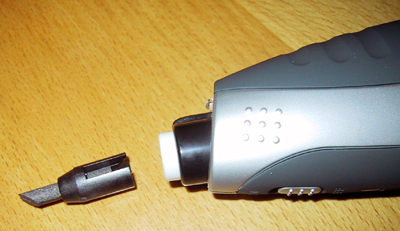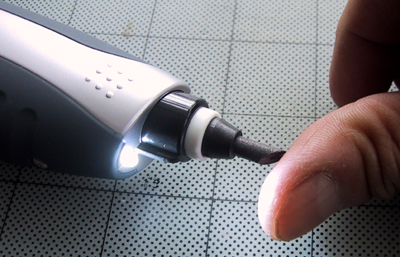
| Today |
| Carolyn's World |
| Gear & Gadgets |
| Garage |
| Garden |
| Kitchen |
| Unaccompanied Minors |
| Workshops |
| Contact Us |
| Index |
| Gear & Gadgets... |
||
The soldering iron has two main components: the tip and the battery compartment. The tip is made of two layers of conductive material separated by an insulator. When the two conductive parts of the tip comes into contact with a something that can transport electricity (solder, wire, etc...) the circuit is complete. I'm guessing that the resistance of the tip is very high...very little current will flow, but a LOT of heat is generated instead.
Some care was put into the usability design of the ColdHeat soldering iron. The unit is powered by 4 AA batteries. We recommend using high quality alkalines or stronger... the cheap batteries didn't last very long.
A red LED indicator at the top of the unit next to the ON/OFF switch comes on when current is flowing... meaning the tip is hot. The tip heats up REALLY quickly. In turn, it will cool down just as quick. We tried the soldering iron on a few different projects. The ColdHeat was designed for and worked really well on all of the small soldering projects (jewelry repairs, light circuit board work, attaching connectors to speaker wires, etc...) we threw at it.
The ColdHeat is inexpensive (under $20 at most places). It fits well in the hand, is highly manuverable in small spaces, and worked just as advertised. This is a GREAT tool for anyone that may need to do any light soldering. It is worth having in the tool box ESPECIALLY if you don't know when you will need it!
|
ColdHeat Cordless Soldering Tool |
|
The ColdHeat cordless soldering tool is one of the more interesting item to come across our desk in a while. We saw it on TV and pretty much dismissed it as one of those late night infomercial gadgets. How can something that is hot enough to melt solder be cool enough to touch in 3 sec? How can something powered by batteries by hot enough to do any useful soldering? Well...we were amazed.
Review Summary: Initial Impression- Excellent Usability- Excellent Durability- Test in progress Price- Excellent Related Reviews: 1. ColdHeat Pro
| ||


 Pushing the power switch to the ON position will activate the white LED and allow current to flow to the heating tip. The tip will NOT heat up unless it touches something that will conduct electricity....so it stays cool. Also, this meant we couldn't accidentally burn things like paper, cloth, or skin.
Pushing the power switch to the ON position will activate the white LED and allow current to flow to the heating tip. The tip will NOT heat up unless it touches something that will conduct electricity....so it stays cool. Also, this meant we couldn't accidentally burn things like paper, cloth, or skin. 

 Finally, I decided to do the "ultimate" test... does the tip cool down in 3 seconds like the commercials? Will it really NOT give me 3rd degree burns? I'm happy to report...it does cool down FAST (3-5 seconds) and my thumb is perfectly fine:-)
Finally, I decided to do the "ultimate" test... does the tip cool down in 3 seconds like the commercials? Will it really NOT give me 3rd degree burns? I'm happy to report...it does cool down FAST (3-5 seconds) and my thumb is perfectly fine:-) 